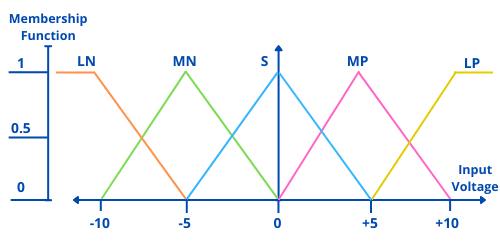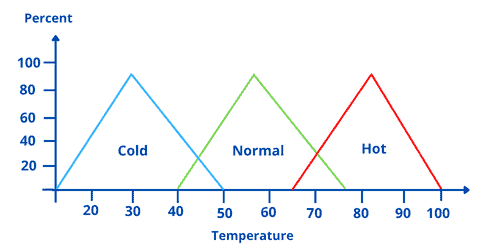1. 概述
在计算机科学中,有多种逻辑推理方法,模糊逻辑(Fuzzy Logic) 是其中之一。
本文将介绍模糊逻辑的基本概念及其工作原理,并通过一个实际示例帮助你更深入地理解它。适合有一定逻辑基础和工程经验的开发人员或系统设计人员阅读,帮助你在面对不确定性问题时,提供一种新的解决思路。
2. 什么是模糊逻辑?
2.1 基本定义
模糊逻辑由 Lotfi Zadeh 提出,其核心在于模拟人类在“是”与“否”之间的中间状态进行推理。不同于传统布尔逻辑的非黑即白,模糊逻辑允许存在多个中间状态。
举个例子:回答“今天冷吗?”这个问题时:
布尔逻辑:只能回答“是”或“否”(即
1或0)
模糊逻辑:可以回答“非常冷”、“有点冷”、“不太冷”等,允许中间状态

2.2 使用模糊逻辑的原因
模糊逻辑在工程控制和实际应用中非常实用,主要体现在:
✅ 能控制机器和消费产品
✅ 在无法获得精确判断时,仍能提供“可接受”的推理结果
✅ 有助于处理不确定性问题,提供“中间路径”的解决方案
3. 模糊逻辑的架构与隶属函数
模糊逻辑系统通常由以下四个核心组件构成:

3.1 规则(Rules)
规则是模糊系统的核心,由专家制定,用于指导系统决策。现代模糊系统通过优化方法减少规则数量,提高效率。
3.2 模糊化器(Fuzzifier)
模糊化器负责将输入数据(如传感器读数)转换为模糊集合。输入通常分为以下几类:
- LP(Large Positive)
- MP(Medium Positive)
- S(Small)
- MN(Medium Negative)
- LN(Large Negative)
3.3 推理引擎(Intelligence Engine)
推理引擎根据输入与规则的匹配程度,决定哪些规则需要执行。执行后的规则组合生成模糊输出集合。
3.4 去模糊化器(Defuzzifier)
将模糊输出集合转换为一个明确的数值输出,常用的去模糊化方法包括:
- 重心法(Centroid method)
- 最大面积中心法(Center of largest area)
- 极大值法(First maxima)
3.5 隶属函数(Membership Function)
隶属函数用于量化模糊集合中每个元素的归属程度,值域为 [0, 1],表示“多大程度上属于某个集合”。
数学表达为:
$$
\mu_A: X \rightarrow [0, 1]
$$
常见的隶属函数类型包括:
- 单点隶属函数(Singleton)
- 高斯隶属函数(Gaussian)
- 三角形/梯形隶属函数(Triangular / Trapezoidal)
下图展示了 LP、MP、S、MN、LN 的隶属函数形状:

输入电压范围为 -10V 到 +10V,输出根据电压变化调整,隶属函数值也随之变化。
4. 模糊逻辑 vs 概率论
模糊逻辑与概率论容易混淆,但两者本质不同:
| 模糊逻辑 | 概率 |
|---|---|
| 描述的是模糊性(模糊性是事物本身属性的不确定性) | 描述的是随机性(事件是否会发生) |
| 表达的是部分真实 | 表达的是部分知识 |
| 基于真值度进行推理 | 基于可能性进行推理 |
| 数学基础是模糊集合 | 数学基础是统计分布 |
⚠️ 别把模糊逻辑和概率搞混了,它们解决的问题类型不同。
5. 模糊逻辑的优缺点
5.1 应用场景
模糊逻辑广泛应用于:
- 航空航天:飞行器高度控制
- 汽车系统:车速控制、交通管理
- 商业决策支持系统
- 化工过程控制(pH 值、干燥、蒸馏等)
- 自然语言处理(NLP)
- 神经网络与人工智能结合使用
5.2 优缺点对比
| 优点 | 缺点 |
|---|---|
| ✅ 结构简单、易于理解 | ❌ 不总是精确 |
| ✅ 适用于商业和实用场景 | ❌ 无法识别复杂的机器学习模式 |
| ✅ 能处理工程中的不确定性 | ❌ 验证和测试成本高 |
| ✅ 对输入精度要求低 | ❌ 规则和隶属函数设定困难 |
| ✅ 成本低,可使用廉价传感器 | ⚠️ 容易与概率混淆 |
6. 模糊逻辑在 AI 中的示例
我们以一个简单的温度控制风扇系统为例说明模糊逻辑的应用。
6.1 隶属函数定义
输入为温度,输出为风扇转速:
- 温度划分为:冷(Cold)、正常(Normal)、热(Hot)
- 风扇速度划分为:慢(Slow)、中(Medium)、快(Fast)
输入输出的隶属函数如下:

6.2 规则定义
我们定义以下三条规则:
- ✅ 如果温度是“热”,则风扇速度为“快”
- ✅ 如果温度是“正常”,则风扇速度为“中”
- ✅ 如果温度是“冷”,则风扇速度为“慢”
规则执行后,会得到一个模糊输出集合,再通过去模糊化处理得到最终的输出值(如风扇转速):

例如,输入温度为 42°C,会同时激活“正常”和“热”两个隶属函数,进而触发两条规则。最终通过去模糊化得到一个确定的输出值。
7. 总结
模糊逻辑是一种模拟人类思维方式的推理机制,适用于处理不确定性问题。它的核心在于:
✅ 隶属函数定义输入输出的模糊集合
✅ 规则引擎进行逻辑判断
✅ 去模糊化得到最终输出
模糊逻辑在工业控制、AI 决策等领域有广泛应用,尤其适合那些无法用精确数学模型描述的系统。虽然它不是万能的,但在某些场景下,它能提供更自然、更符合人类认知的解决方案。